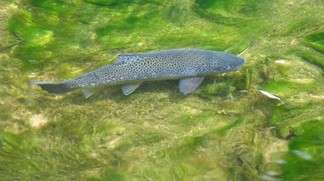EPFL's heating a treat for lake trouts

A recently conducted study also shows that the streams surrounding EPFL can handle future campus growth.
Since 1985, the EPFL has relied on water from Lake Geneva to heat and cool their buildings. Once used, this water is injected back into the nearby streams. For his Master's project at the Ecological Engineering Laboratory, Jonathan Sidler studied the impact of this alternative heating approach on the health of the stream ecosystems, which contribute to the mating grounds of one of the largest lake trout populations in Western Europe. Surprisingly, he concluded that injecting lake water into the streams improves their overall ecological quality and their attractiveness to the fish.
Influenced by the 1970s energy crisis, a decision was made in the mid 1980s to heat and cool the buildings of the EFPL campus using water from Lake Geneva. Extracted at depth of 68 meters below the lake's surface at 6°C, this water is warm enough to supply heat in the winter using heat pumps and to absorb excess heat in the summer. As a result, heating oil consumption has decreased considerably since before the introduction of this approach over 25 years ago - and that despite today's much larger campus.
Sidler's Master's thesis focuses on analyzing the impact of the heating and cooling system on the stream ecosystems and makes predictions on the impact of the campus expansion that is underway. His project was spawned in an attempt to evaluate the water quality of the Sorge, the Mèbre and the Chamberonne that flow near EPFL and UNIL. Water fed back to the streams after passing through the heat pumps, located near the Sorge metro station, was diluting the river water, as well as the water contamination that was under examination. Finding a way to account for this dilution opened the door to Sidler's investigations.
Bringing back lake trout
Lake trout, an indigenous species to Lake Geneva that can weigh well over 15 kilograms, tend to be picky in choosing where they mate: preferably in rivers, where the temperatures are not to warm in the summer, and neither too warm nor too cold in the winter. If the river water falls within this narrow temperature range, the fish find conditions in which they can reproduce and thrive.
While the fish may have been adapted to the river's environment in the past, agricultural practices and urbanization have had an impact on the temperature and flow rates of the streams, making them less attractive to the trout. "By injecting the used lake water back into the streams, we actually cool them in the summertime and early winter, keeping the temperatures within a range that the fish are adapted to. Besides that, we help maintain river flow even in the dry season, and dilute any pollution that is present in the rivers," explains Luca Rossi, who supervised Sidler for his Master's thesis.
What is good for the fish is not necessarily beneficial to other species. The arbitrary changes in flow rate that depend on the heating and cooling needs of the campuses could spell trouble for beaver populations that have settled nearby. But a growing beaver population suggests that the fact that the rivers never run dry outweighs the detrimental effect of fluctuating flow rates.
An outdoor lab surrounding campus
As the campus expands, the demand for lake water will increase, as will the amount of water injected back into the rivers. Using computer simulations, Sidler was able to predict the bounds on the temperatures that the river will be exposed to. Taking into account two major construction projects that are underway, the conference center at EPFL and the Geopolis building at UNIL, both of which will adopt the same approach for heating and cooling, he showed that the rivers could sustain this increase. The Sorge river, however, would be pushed close to its limits, especially in the winter months, when the water used for heating would be injected back into the already cold river.
Besides addressing these pragmatic questions in need of an answer, this project is laying the groundwork to using the Sorge, the Mèbre and the Chamberonne as a lab ecosystem in EPFL's backyard, in the same way that Lake Geneva has been used in the Leman21 and élemo campaigns. "Now that everyone knows that we have a lake, it's about time that we take advantage of our rivers," says Rossi.
Provided by Ecole Polytechnique Federale de Lausanne
















